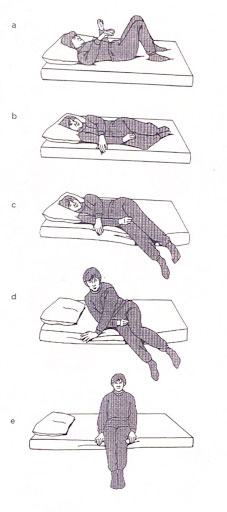The main role of the physiotherapist is to instruct you in an exercise program and to assist you in regaining independent mobility.
Pre-operatively
The physiotherapist will visit to discuss your general health and activity levels as well as answer any questions regarding your physiotherapy treatment. They will teach you the correct method of getting in and out of bed and explain precautions that will be relevant following your surgery.
Day of surgery
You need to commence your deep breathing exercises and foot and ankle exercises as soon as you are fully awake and your physiotherapist will see you the next day.
Day 1- Post surgery
The physiotherapist will assist you out of bed and mobilise as tolerated and assess your ability to mobilise independently. They will review your bed exercises and teach you further exercises to optimise your recovery. From this point onwards, the physiotherapist will assist you to progress your mobility, in preparation from the patients discharge home.
Before going home
- You should be walking independently.
- You will be assessed walking up a flight of stairs as appropriate.
- You will be well informed of how to look after your neck, and how to progress your mobility.
Walking and muscle activity help to prevent many postoperative complications. Once able to do so safely, ensure you walk around your room and the ward throughout the day as directed by your physiotherapist. Do not attempt to walk on your own until you are assessed as safe to do so.
Exercises:
Deep breathing exercises
The aim of these exercises is to maintain lung expansion and prevent airway collapse, which can sometimes occur following surgery. It is best to do these in a comfortable upright position with shoulders relaxed. Breathe in deeply, feeling your lower ribs expanding outwards. Repeat 3-4 times. Perform these exercises hourly initially. As you become more active you will need to do the breathing and circulation exercises less often
Circulation exercises
The aim of these exercises is to decrease the risk of developing a Deep Vein Thrombosis (DVT) or Pulmonary Emboli (PE). DVT is most likely to occur when the muscles are inactive for long periods, for example, during prolonged bed rest. Contraction of the leg muscles, like when you walk around, has a pump-like action, allowing the blood to circulate.
You will need to do the following exercises hourly in hospital or follow the instructions of your physiotherapist:
- Firmly move your feet up and down at the ankles in a pump like action.

- Roll your ankles in a circular movement, round and round. b) Squeeze your thigh muscles by pressing the back of your knee down into the bed. Hold for 3 seconds.
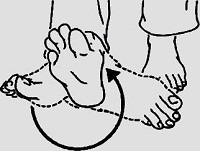
- Squeeze your buttock muscles together. Hold 3 seconds.

Lower abdominal exercises
The lower abdominal and pelvic muscles provide stability for your back by acting like a corset. These muscles are often weak in people with low back pain and following back surgery. The following exercises will help to retrain these important muscles, and can be started day 1 or 2 after your surgery
Transverse abdominis
This can be done in any position (e.g. Lying, sitting or standing) but you may be more comfortable initially lying on your back. The contraction of the muscle is quite subtle and needs to be specific, it should not cause pain.
- Breathe normally. Keep shoulders and chest relaxed. Find a neutral spine position, or position of minimal pain.
- After an outward breath, gently flatten the lower abdominal wall (pull your navel towards your spine). Hold the contraction while continuing to breathe normally.
- Hold for 5 breaths, aim to repeat this 5 times, four times per day. d) Gradually hold the contraction longer, aiming for 10 breaths and 10 repetitions.
It is good to hold this contraction while getting in and out of bed, sitting or standing.
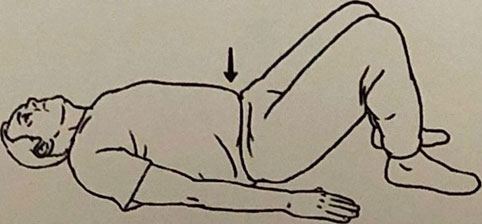
Pelvic tilt
- Lie on your back with legs bent.
- Exhale, tilting top of pelvis back to flatten your lower back.
- Inhale, rolling your pelvis in the opposite direction to bring the top forward and to form a small arch in your back.
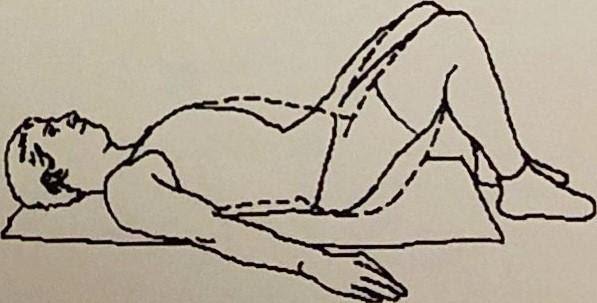
Back exercises
Trunk extensors
The long muscles down the length of your spine (extensors) need to be strong to support your back.
- Lying flat on your back, with arms at side, press left shoulder and right leg down into the bed.
- Hold for 5 seconds then slowly relax, do not arch your back off of the bed.
- Then again with right shoulder and left leg.
- Repeat 5 times, 2-3 times a day.

Stretches
After surgery, the nerves can become tight, so it is helpful to gently stretch the nerves to encourage length and mobility.
Neural Stretch
This exercise can be done lying flat on your back with a rolled-up towel under heel.
- Gently bring toes towards head until you feel a stretch and then release.
- Repeat on each leg, 5 times, 2-3 times a day.
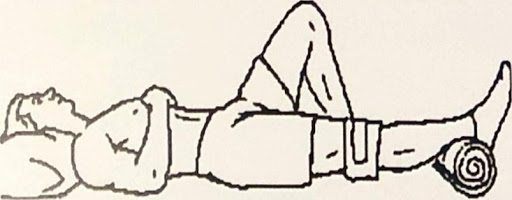
Calf Stretch
- Stand with one foot back with the leg straight and the other leg in front with the knee bent.
- Exhale, tilting top of pelvis back to flatten your lower back
- Lean in to the wall until a stretch is felt in the back calf muscle.
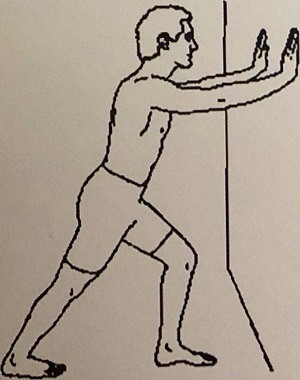
Exercises to continue on discharge
These exercises are to be started after your discharge from hospital in combination with the previous exercises.
Exercises should not cause pain, do these exercises only as comfort allows.
Squats
It is important to build up the strength of your legs, if your leg muscles are strong, they will take the load off of your back.
- Stand with your feet shoulder distance apart and about 15cm 20cm away from a wall.
- Slide your bottom down the wall, making sure your lower back is flat, abdominal muscles are tight, buttock muscles are tight, and knees are over your toes.
- Slide down the wall until your knees are bent to 30 degrees.
- Hold for 3 seconds and then slowly slide up the wall until your legs are straight.

Calf Raises
- Holding a stable object, rise up on your toes
- Hold for 3 seconds.
- Then rock back on heels and hold for 3 seconds.
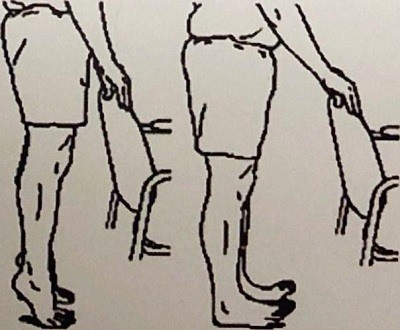
Transverse abdominis progression
- Lying with knees bent and a neutral spine, arms resting by your side.
- Inhale to prepare, then while exhaling lift both arms above your head or as far as you can control, ensure that the rib cage remains soft.
- From this position, inhale and hold for 3 seconds.
- Exhale while lowering both arms to return to starting position.
Start with 3 - 5 repetitions of each exercise, and build up to 10 - 12 as comfort allows.

Walking
Walking is the best exercise that you can do for your spine and for your recovery. Regular exercise improves the function of your heart and lungs and increases your ability to perform physical activities. It also increases confidence, self-esteem and independence, aids relaxation, improves sleep, and reduces stress.
- Try to walk 1-2 times a day initially, building up to 4-5 times per day.
- Try to walk as normally as possible.
- Keep an upright posture, relaxed shoulders, and swing your arms when you walk.
When you go home, gradually increase the amount of walking you do each day. Increase the distance or the amount of time you spend walking, as guided by your level of comfort.
Getting in and out of bed
The physiotherapist or nurse will assist you with your first walks, do not attempt to do this on your own.
It is essential that you “log roll” whenever you are going to get out of bed, as this is the safest and most comfortable method.
Self-help poles/monkey bars are not permitted.
- While lying in your back, bend up your knees one at a time by sliding your feet towards you.
- Roll onto your side keeping your hip and shoulder in line
- Drop your feet over the edge of the bed.
- Come up into sitting by using your arms to push up on the bed.
- Perch/sit up on the edge of the bed for a minute, as you may feel dizzy or light-headed.
